Devon summer gardens tour
Sunday 26 June – Thursday 30 June 2022
Listed below are the gardens or areas with wild flowers that we visited during the tour in the order they were visited:
Wildside, Buckland Monachorum
The Garden House, Buckland Monachorum, Yelverton
Hotel Endsleigh garden, Milton Abbot
RHS Rosemoor, Torrington
Higher Cherubeer, Winkleigh
Braunton Burrows, a sand dune system on the North Devon coast
Clovelly Court Gardens, Clovelly, Bideford
Hole Farm, Woolsery, Bideford
Marwood Hill Gardens, Marwood, Barnstable
Monday – Wildside
This garden is owned by Keith Wiley, an author and photographer as well as a gardener. Together with his late wife Ros, Keith made it what it is today. They first met as students at Wye College, and worked at the Garden House before creating this garden at Wildside. Work was started in 2004, their inspiration coming from natural landscapes.
Sarah, a volunteer, met us on arrival, and kindly gave us a history of the garden and an explanation of the various areas within the garden which we could explore and see for ourselves. Andy, also working in the garden, was available for more specific questions, such as the various plant names.
Wildside was originally a bare field. In the beginning a lot of soil had to be shifted, enabling Keith and Ros to give the garden the form and structure that it has today. This gave different depths to the soil which has allowed for the various growing conditions within a small zone. It opened in 2008.
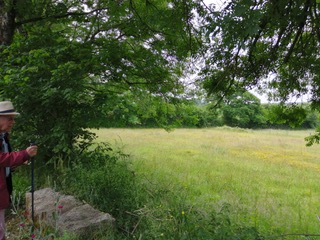
In all there are four acres, divided into three main areas, the canyons, the courtyard and the lower garden with its acer glade, a South African style garden. There are more than 4000 different plants and a plant nursery, not open to visitors. Ros died of cancer in 2019 and, as a tribute to her, Keith has been developing the canyons area.
In the lower garden, wild flowers mingle and interact within the landscape, giving a first impression of a vast palette of colours. It is these colours that Ros took and skilfully transposed onto her canvasses. There is a studio in the garden where many of her paintings are displayed.
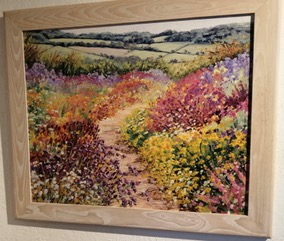
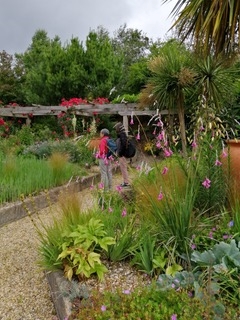
Of particular note in the lower garden are the dieramas in their varying shades of pink and white and also the grasses. The plants are tall enough that one feels drawn further into the garden just to see what is around the next corner. At the bottom of the lower garden are the ponds, surrounded by astilbes, irises and many other moisture-loving plants.
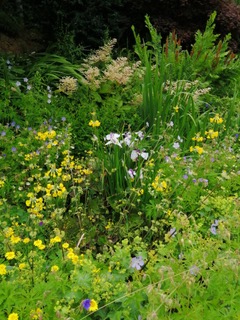
There are a number of sheltered seating areas to be found around the garden, each giving a special vista. As one walks around, the different scents given off by the various plant species are especially noticeable.
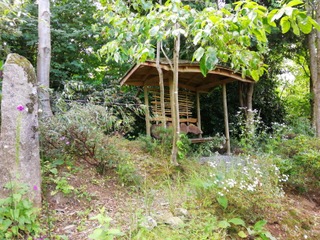
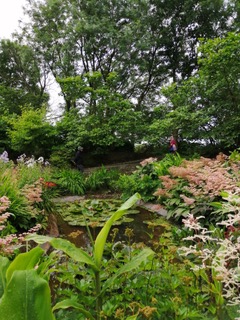
The courtyard garden is sited between the lower garden and the canyons garden; it has many Mediterranean plants and a more formal design.
In the canyons, being developed as a tribute to Ros, the intention was to grow low vibrant red, orange and yellow flowers among silver shrubs, near water. Masses amounts of earth moving was required to achieve the necessary basic structure. There are steep slopes with intertwining paths. The colour variety is achieved using varieties of Kniphofia, Dierama, Agapanthus and Watsonia amongst many others.
Further into the canyons can be found the alpines.
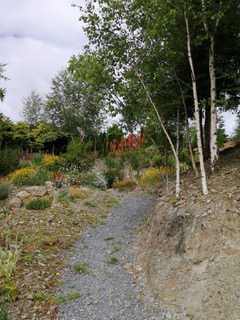
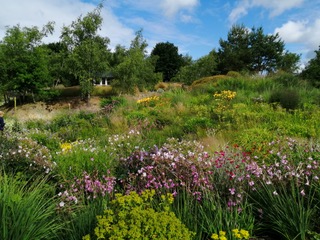
The Garden House
The next garden, dating back to 1305, was only a few minutes away from Wildside and our group was greeted by Paul, the operations manager. Unfortunately, Nick Haworth, the head gardener who has been at the garden since 2013 and was due to give us a tour, was unavailable. The garden stretches over 10 acres. Of particular interest at the time of our visit were the summer garden and the walled garden.
The house has been the home of the vicars of Buckland Monachorum and was built in the early 19th century and is still a vicarage. The house and land were bought by the Fortescue family in the 1940s. In 1961 a Trust was established and, after the death of the Fortescues, it became a charity in the 1980s.
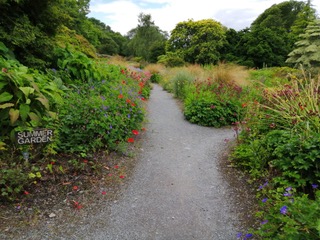
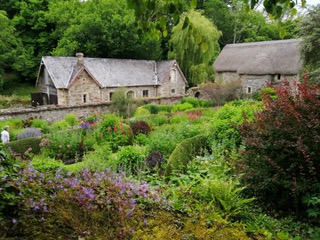
There are themed areas: the cottage garden, the acer glade, the walled garden, the summer garden and the Jubilee Arboretum (opened in 2013), being the main ones. The summer garden showed evidence of the work that Keith Wiley had carried out during his time working here. There are also a plant sales area, a cafe and book shop. After a most welcome coffee break our members made their way around the garden to the areas of particular interest. The garden is worked by a number of full time staff, two students and a team of volunteers.
There are memorial plaques in the garden to commemorate Tom Hooper who was a gardener here from 1945 – 1990.
The garden is currently undergoing major refurbishment and there is always on-going maintenance.
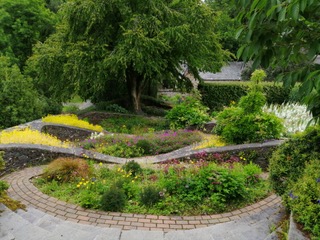
There are many rhododendrons and they were a particular favourite of Lionel Fortescue. His aim was to get perfect plants and he raised many new cultivars to which he gave local names such as Buckland (from the village name) and Fortescue.
At the far end of the garden are the remains of an avenue of lime trees. Only a couple remain standing since four trees were lost during Storm Eunice which raged earlier this year. Two of the fallen trees have been left where they fell. One can see their great size and what a great loss they are to the garden.
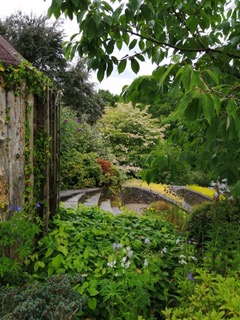
The majority of plants are labelled. Of interest is the Phillyrea angustifolia hedge in the walled garden. It can be used in place of box or privet for hedging. Here, the sinuous form is particularly attractive.
Also in the walled garden and at its best at this time of year is the Eucryphia Lucida ‘Ballerina’, a small tree originating from Tasmania.
Alistair, a volunteer working here, was most helpful in imparting his knowledge on the plants.
After lunch in the sun overlooking the lawn area and a visit to the plant sales area, we set off for Hotel Ensleigh.
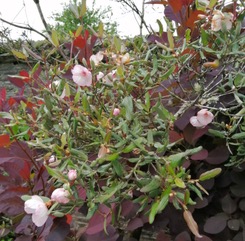
Garden of Hotel Ensleigh
As one drives towards the hotel, which is part of the Polizzi collection, there are mature rhododendrons along the side of the road. We were to be shown around by the head gardener, Ben Ruscombe, but he had Covid so we used the maps provided to self-guide. There were two walks to choose from, a half-hour one or a longer one of an hour and a half.
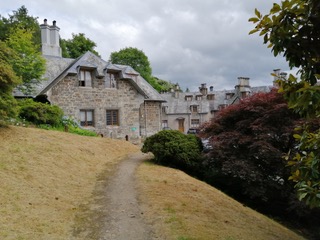
This 108-acre site was originally chosen by the then Duke of Bedford for his fishing and hunting lodge overlooking the River Tamar. It is made up of gardens, woodlands, follies and grottoes designed by Humphry Repton, worthy successor to Lancelot “Capability” Brown. The architect was Sir Jeffry Wyatville. There are several Grade 1 listed buildings in the grounds and the gardens are Grade 1 listed by English Heritage. The house is surrounded by formal gardens including a herbaceous border, a rose walk and a yew walk. At the end of these is a shell house dating back to the early 19th century.
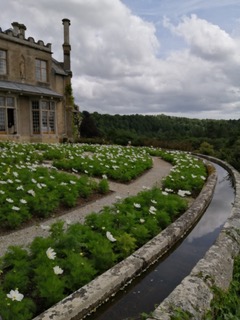
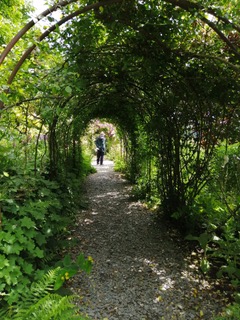
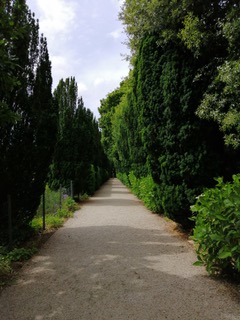
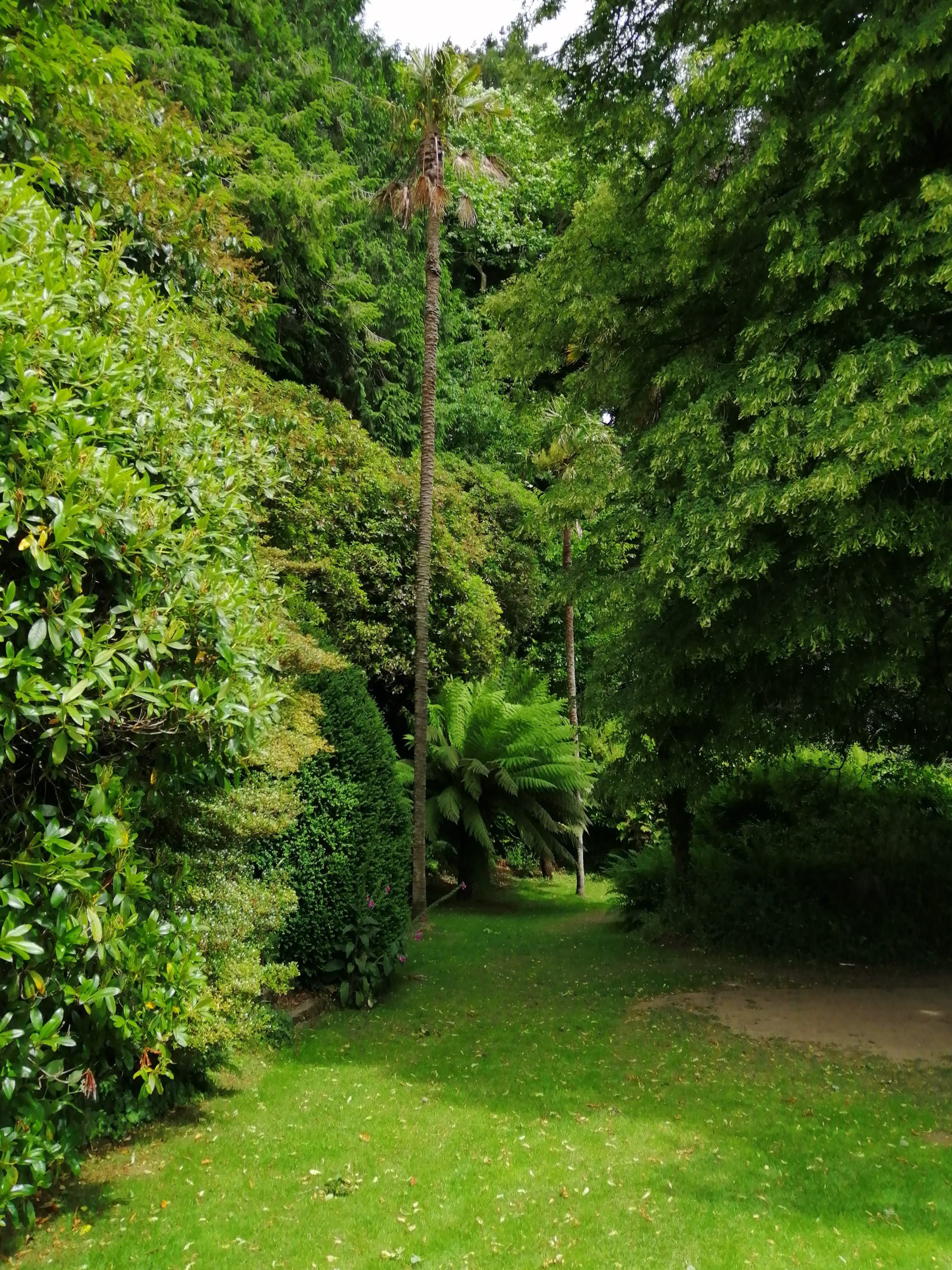
In the dell, there are specimen trees from around the world which were identified on the map plan. Here also, the plants are generally given free rein to grow. Features of the dell include a rockery and waterfalls. Beyond the river, there is a predominance of Scots pine. The property is known for its quietness and tranquility, and two birds of prey were circling overhead. After the walks, a delicious Devon cream tea was served on the parterre.
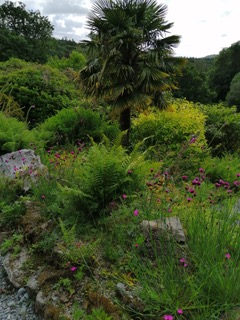
Tuesday – RHS Rosemoor
RHS Rosemoor is a 65-acre garden surrounded by over 100 acres of woodland in the Torridge valley and has 40 inches of rain a year.
Rosemoor has a number of National Collections, including that for Ilex and Cornus. There are 20 full time gardeners, five apprentices and a team of volunteers. The gardens are divided into two parts by the A2134 with an underpass that allows access between them.
Rosemoor has one of the UK’s largest rose collections which were looking good.
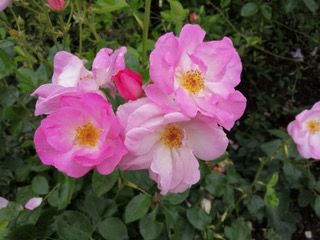
These are the Queen Mother’s rose garden and the shrub rose garden. The Queen Mother’s rose garden contains mass plantings of modern roses bred since 1867. It includes floribunda and hybrid tea roses. The shrub rose garden is quite different, its beds are not only filled with roses, but are interplanted with colourful perennials including astrantia, geraniums and penstemons which are especially colourful at this time of year.
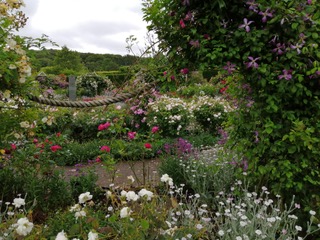
The hot garden and the cool garden, which is only three years old and a Chelsea winner are also recommended for viewing, as are the natural wild flower meadows, the cottage garden and the upper bog garden.
On assembling near the main entrance, we were met by Diana who was to be our guide for the next two hours.
She explained that the main garden area was divided up into what are in effect rooms divided by yew hedges. These have had to be replaced owing to the disease Phytophthora which attacked the original hedges.
We were given a brief history of the garden, where it was explained that Lady Anne Palmer, daughter of R.H. Walpole, founded Rosemoor. She lived here from 1945 until 1988 when she offered the garden to the RHS. During the war, the house was converted into a Red Cross hospital. At the age of 77, after the death of her first husband, Lady Anne remarried, having met her second husband in Spain where they found that they had a mutual interest in plants. They later went to live in New Zealand where they established an arboretum. She lived until she was almost 100 years old and he lived until he was 101.
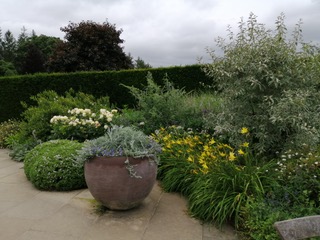
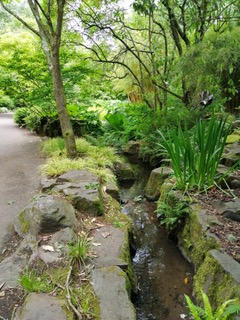
We then set off to see the herb, potager and cottage gardens. Here we saw decorative pergolas, willow fences and hazel twigs which support the climbing fruits and vegetables. It was explained that the corner sections were meant as an example of an area sufficient to feed a family of four. When the vegetables are finished, they are replaced by a new set allowing for on-going produce.
Rosemoor has an allotment school which runs from February to October which has proved very popular.
The cottage garden is a small typical Devon cottage garden with an authentically constructed thatched summer house.
In the wild-flower meadow there are yellow rattle (Rhinanthus minor), orchids, knapweed (Centaurea) and various grasses. The area is cut twice a year in March and September. This is necessary so that the yellow rattle will grow successfully.
The stream garden and rock gully area was until recently a stream with muddy banks but has been developed into what it is today by sourcing rocks from a local quarry and landscaping with appropriate plants.
We continued through the underpass to what is known as Lady Anne’s garden. The temperature here is noticeably warmer and hence it has a very different feel about it. The original house has been converted into holiday apartments with a coffee shop to one side. The pond, which was next to the house had to be moved to the other side of the road due to leakage onto the road. and has been turned into a lake.
We walked on through the exotic garden, where the soil pH is 5, and then on to the Lion Terrace which was designed by Lady Anne’s mother. This consists of a water feature, pavings and a lion statue as well as a small seating area.
We then moved on to the croquet lawn, which features southern hemisphere plants around the edges These include Lobelia, Gladiolus, Roscoea, Berkheya and Watsonia. Kniphofia dominate, but there are many other plants of interest too. The hedges on one side have been removed to open up a vista looking south-east towards the arboretum. We then moved onto the Mediterranean garden. Originally this was a tennis court, and then later a garden with dwarf conifers. The area is dominated by a very large old oak tree. There was some discussion as to whether it should be felled to allow more sun and warmth to this area.
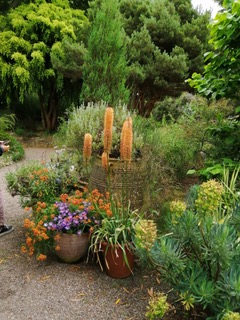
After our whirlwind tour, we were free to wander as we pleased and have lunch. Other gardens visited were the hot garden, where depending on the season the flowers include Verbena, Alstroemeria, Coreopsis and Hemerocallis. These are followed later in the year by Helenium, Rudbeckia and Monarda. Various grasses are also present.
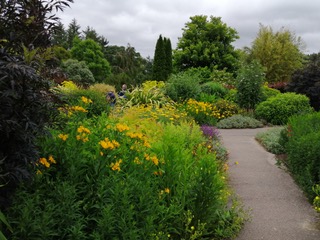
The cool garden designed by Jo Thompson was a clear favourite with great colour combinations and a decorative rill. Flowers still to come included Agapanthus and Buddleia.
Before leaving Rosemoor, there was a chance to visit the garden centre and take a closer look at the summer bedding near the entrance including frost-tender perennials native to South Africa, South America and the Mediterranean, with Canna, Osteospermum, Nemesia, Pelargonium and Argyranthemum. The plants were arranged in informal drifts using pastel flower colours and a variety of foliage colours, shapes and textures.
Our time was coming to an end and after meeting up with the group we gathered to move on to the next garden.
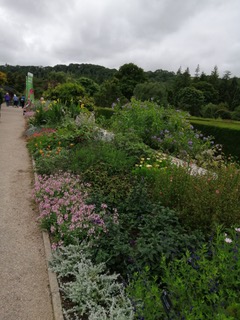
Higher Cherubeer
We were welcomed at the “wedding gate” and given a history of the garden by owners Jo and Tom Hynes, MPG members. They have lived here since 1990, having moved from their previous home where the garden was also an NGS garden. It took much longer to gain this status here, almost 12 years. It was opened in 2003. Initially they thought of opening a plant nursery. The soil here is acid clay.
When they took the property over, it was a 50 acre run down farm. One of their first purchases was a herd of pedigree Devon bullocks. This was later followed by sheep kept both for showing and breeding.
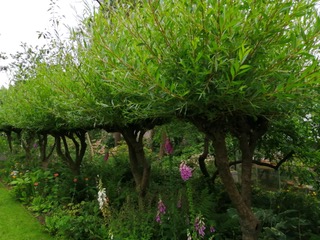
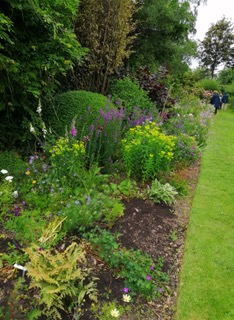
To start the garden, some serious earth moving with heavy equipment was necessary. Using these, the lawns and terraces were constructed. A large number of trees were planted around the same time to act as a shelter belt. Eight of these were removed in May this year as they were getting too large.
The garden of one and three quarter acres consists of a gravelled court yard and paths, raised beds, an alpine house, lawns, a herb border and woodland beds containing snow drops and cyclamen. There is also a kitchen garden with a large green house, containing a wide variety of peppers, and an orchard. There is no hoeing in the woodland garden because of the bulbs. Instead a cardboard or newspaper mulch is used to suppress the weeds as well as grass cuttings.
This garden holds the National Collection of snowdrops; there are more than 400 varieties as well as a National Collection of cyclamen, and there is also an interest in ferns. It opens in February to show these and other bulbs to the public, and again in September for the other garden plants.
There are future plans to build a welcome structure at the entrance and a lake and reed bed on the recently purchased five acres of woodland. Generally farmers in this area are moving out of farming and into environmental projects.
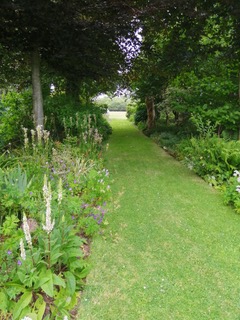
Unfortunately this visit was rained on. Some said it felt even colder than when another MPG group visited in February. However, this was soon forgotten with the most welcome tea and cakes in the conservatory following the garden tour.
Wednesday – Braunton Burrows
It was an ominous start to the day with some heavy clouds overhead but, undaunted, we set off prepared. We were met in the Sandy Lane car park by John and Mary Breeds, our guides for the morning. John was warden here from 1979 – 2009 and Mary describes herself as a self-employed ecologist. Braunton Burrows is one of the largest sand dune systems in the British isles. It is sited at the estuaries of the Tor and Torridge rivers. It is privately owned by the trustees of the Christie estate. The name refers to the rabbits which live on the dunes.
It is a UNESCO designated biosphere reserve and a site of special scientific interest (SSSI). It is also used by the Ministry of Defence (MoD) for training exercises as well as being a popular destination for recreational use – hiking, dog walking, and for nature lovers. It has always been open to the public, allowing unrestricted access. Between 1943 and 1944 it was used to train 10,000 American troops prior to the D-day landings in Normandy. The beach was used to practise for amphibious landings. The area covers 1800 acres and consists of dunes, slacks (damper areas), grassy plains, dense scrub and ponds. There are more than 470 species of flowering plants including 11 species of orchid. Over the whole area, there are a variety of unique habitats.
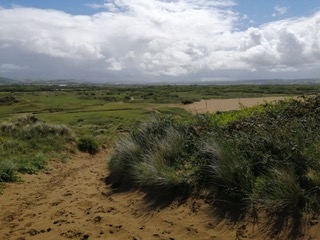
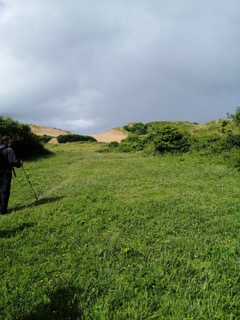
Our group divided in to two, one taking a longer walk than the other.
The management of the Burrows is by mechanised scrub clearance and grazing by traditional cattle breeds as well as rabbits. These help reduce the overgrowth by brambles and sea buckthorn which would otherwise smother the flowers.
On the way to the dunes we passed a number of Umbellifers. Of particular interest were the Conium maculatum (hemlock) and Heracleum (hogweed), the hemlock being highly poisonous.
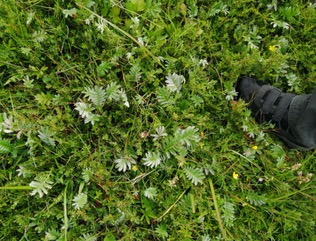
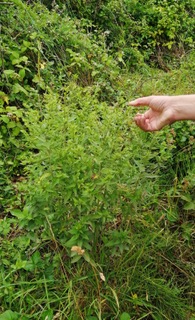
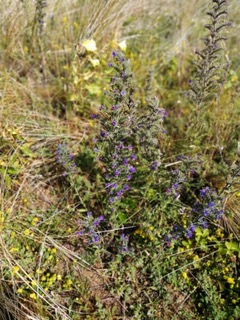
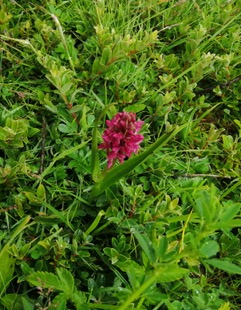
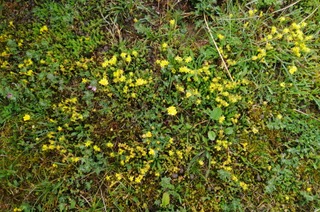
Other wild plants that we saw include: lady’s bedstraw, eyebright, horse tails, creeping willow, storksbill, marsh helleborine, purple loosestrife, adder’s tongue fern, wild thyme, biting stonecrop, and many, many others. Some areas had no wild flowers at all where the MoD have night training exercises, pitch tents and use heavy vehicles or where sand had blown. For those who wish to know more of the area, Mary has written Wild Flowers of Braunton Burrows.
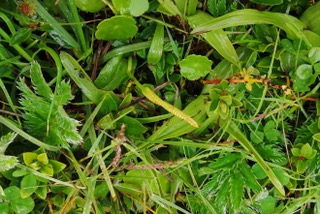
Clovelly and Clovelly Court Garden
Our next stop, about an hour’s drive from Braunton Burrows, was Clovelly where we had lunch. Tickets are required to enter the privately owned fishing village and Clovelly Court Garden. The village has steep cobbled narrow streets which cannot take cars and in the past donkeys were the main form of transport. There are still some donkeys around, but they are no longer expected to work. Incidentally there are three defibrillators in the village, for obvious reasons. Some of the group ventured down the hill, others stayed at the top and enjoyed the view across the bay while they ate their lunch.
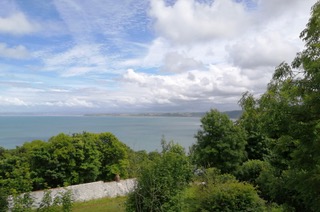
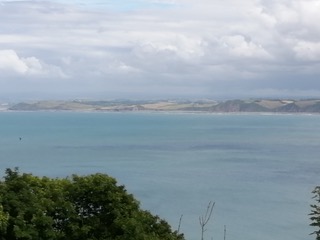
We were met at the entrance to Clovelly Court Garden by the head gardener, Neil. We were especially lucky to have him show us round as he is recovering from triple bypass surgery following a heart attack in April.
The garden is a Victorian walled kitchen garden built originally to supply the village and the manor house. It still supplies produce to the Red Lion in Clovelly and plants for hanging baskets in the village and hotels. It is organic with a soil pH of 6. In the past, cut flowers were regularly sent to Covent Garden. Vegetable and fruit production takes precedence over the ornamental plants.
There is a team of three full time gardeners as well as five volunteers doing half a day each week. In its heyday, there were 12 full time gardeners.
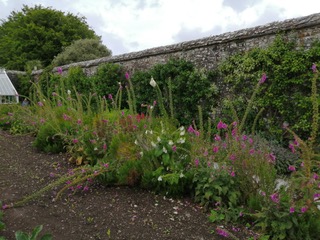
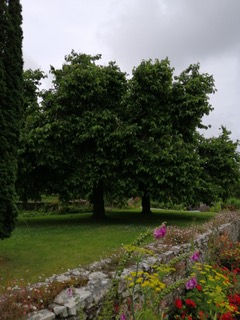
The garden walls were originally built to give the garden protection from the salt-laden coastal winds in the 18th century, with renovations done in the late 20th century. Due to the effects of the warm Gulf Stream, the produce is a month ahead of the normal season. The peaches and apricots flower early and need to be hand pollinated as there are few bees around at this time of year. The walls are bordered by herbaceous flower beds.
The air temperature was noticeably different to that outside the garden, being about 2 °C warmer. There are no frosts here.
At the entrance to the garden is a 150-year-old Cercus siliquastrum, or Judas tree, said to be the oldest in North Devon.
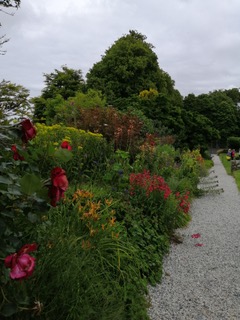
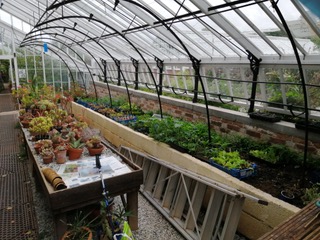
The garden has original Victorian greenhouses used to grow apricots, peaches, nectarines, and melons. Some of the original cast iron structures are still in evidence. There are grape vines too, one of which is more than 90 years old. Also grown are citrus fruit, figs, cucumbers, peppers, chillies, aubergines and tomatoes. The summer house was designed by Rex Whistler in the 1930s.
Outside there are fruit trees with espaliers and cordons lining the garden walls. There are apple trees, (some more than 70 years old), pears, quinces, medlars, and soft fruit. Also near the centre of the garden are two mulberry trees; at one time their leaves were used for silk worms to produce silk. These are still good croppers despite their age. A large amount of borage is grown for the bees and as a liquid compost. One of the village chefs freezes the flowers for culinary use. Nasturtiums are grown for use of both flowers and seeds in salads.
After sampling some absolutely delicious apricots, we all returned to the coach to be driven to our last garden of the day.
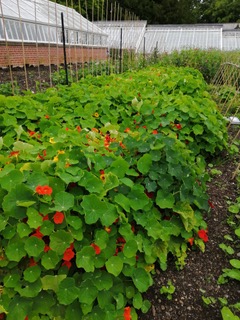
Hole Farm
There are many farms in the UK with this name, “hole” meaning “hollow”. The working farm which breeds pedigree native Devon cattle is over 400 years old but the garden was started 20 years ago. A few hours before our visit a calf was born by caesarean section. It was also a special day as the garden recently completed its tenth year in the National Garden Scheme and Jo Hynes presented the owner, Heather Alford, with a trowel to mark the occasion.
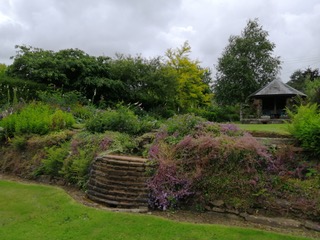
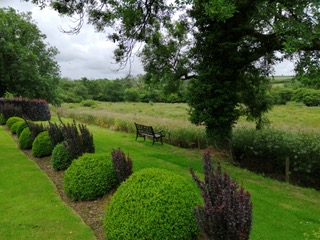
The garden has a walk along the River Torridge and consists of three acres with a feature waterfall, ponds, a vegetable area and a bog garden. It is made up of terraces, and includes a round house. The hedges are a mixture of native plants, including Acer campestre (field maple). The stones used to build the walls in the garden came from the farm quarry.
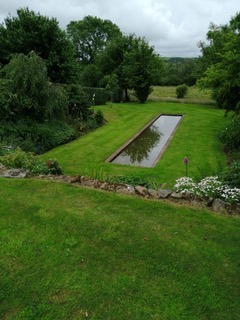
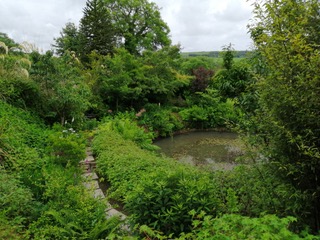
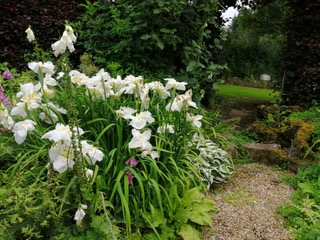
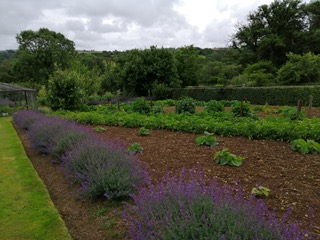
The land is culm grassland and water meadow. Culm grassland is a rare habitat peculiar to North Devon. It is a type of purple moor-grass and rush pasture and is important for biodiversity. It has real potential to hold water, filter pollution and retain carbon. After hearing about the garden and farm, we were free to wander as we wished then had tea and biscuits in the large barn.
Thursday – Marwood Hill Garden
The botanic garden covers 20 acres and has three National Collections: Thulbaghia, Astilbe and Iris ensata, of which it has over 100 cultivars, the originals having come from Japan. These irises have been cultivated in Japan for over five centuries. The newer forms have come from America. Ensata means “happy news” or “gentle heart”. They are slender-stemmed, beardless and beautifully inscribed with intricate markings and flower in midsummer. It can be seen in the bog areas alongside the stream in the gardens.
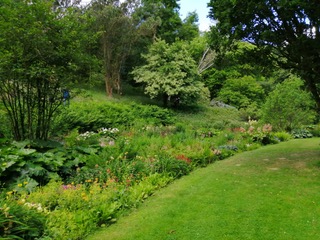
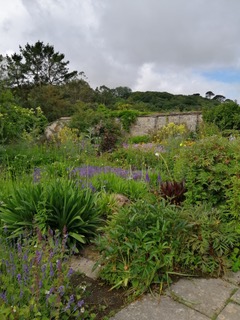
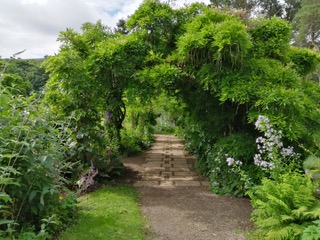
The property – then an eight-acre steep-sided grassland valley – was bought by Dr Jimmy Smart in 1949. A shelter belt of pines, cypresses and magnolia was put in first. In 1969, two lakes were created, one with an island with a statue of ‘Mother and Children’ by John Robinson. A third lake is beyond the bog garden.
In 1972, Jimmy Smart left his original house and moved into a new one built within the grounds. He concentrated on the garden until he died in 2002, dedicating the garden to its visitors. The house became what is the tea room today. A Mediterranean garden is being developed. Surrounding the garden is extensive woodland with camellias, rhododendrons, magnolias, flowering dogwoods, hydrangeas and eucalyptus trees.
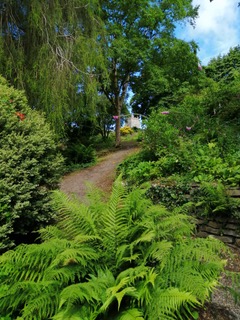
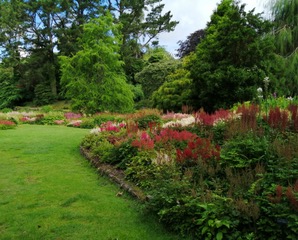
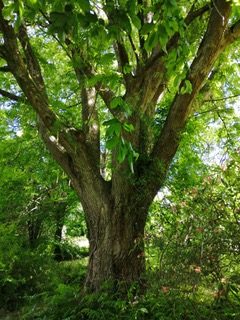
This garden is one where there is little disturbance from outside distractions, and bird song is to be heard everywhere. A couple of trees of interest are the Pterocarya x rehderiana, planted in 1980, and a purple pyramid beech.
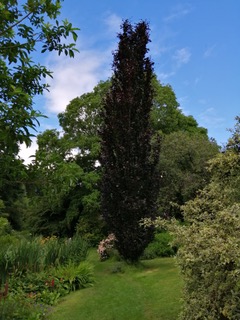
This was the final garden of the tour and, after a cup of tea and a delicious home-made scone with clotted cream and honey, we parted company and made our various ways home. We knew at the time of our visit that intensive preparations were under way for the RHS Hampton Court show the following week and a bonus to be discovered later was that Marwood was to win two prizes including a Gold Medal for their Astilbe display there.
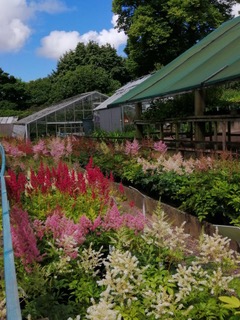
All in all this was an exciting and stimulating venture to see some of the beautiful sites and gardens that Devon has to offer. Many thanks to Jo and Tom Hynes for the excellent programme and their hospitality, and to Maddy Hughes for the organisation.
Text and images by Anne Curtis

